Vehicle Intelligence Systems Market Size 2025-2029
The vehicle intelligence systems market size is valued to increase by USD 22 billion, at a CAGR of 15.8% from 2024 to 2029. Stringent safety regulations and mandates will drive the vehicle intelligence systems market.
Major Market Trends & Insights
- Europe dominated the market and accounted for a 34% growth during the forecast period.
- By Component - Sensors segment was valued at USD 4.45 billion in 2023
- By Technology - Adaptive cruise control segment accounted for the largest market revenue share in 2023
Market Size & Forecast
- Market Opportunities: USD 294.59 million
- Market Future Opportunities: USD 22004.10 million
- CAGR from 2024 to 2029 : 15.8%
Market Summary
- The market: Driving Towards Enhanced Safety and Operational Efficiency The market is witnessing significant growth as the automotive industry shifts towards advanced technologies to ensure safety, optimize supply chains, and comply with stringent regulations. These systems, which include advanced driver assistance systems (ADAS), telematics, and vehicle diagnostics, are transforming the way vehicles are manufactured, operated, and maintained. Fuel efficiency monitoring, in-vehicle infotainment, vehicle dynamics control, and network security protocols are crucial components of this market. One of the primary market drivers is the increasing focus on safety and regulatory compliance. For instance, the European Union's eCall regulation mandates all new passenger cars to be equipped with an eCall system by April 2018. This system automatically dials emergency services in the event of a severe accident, improving response times and potentially saving lives.
- Another significant trend is the rise of software-defined vehicles, which enable over-the-air updates and remote diagnostics, enhancing operational efficiency and reducing downtime. For example, a leading logistics company reported a 18% improvement in uptime by implementing a vehicle intelligence system that monitored engine performance and alerted maintenance teams to potential issues before they escalated. However, the high cost and complexity of advanced systems pose challenges for market growth. Manufacturers must balance the benefits of these technologies with the costs and ensure that the systems are user-friendly and reliable. Despite these challenges, the future of the market looks promising, with continued innovation and advancements in technology driving growth.
What will be the Size of the Vehicle Intelligence Systems Market during the forecast period?
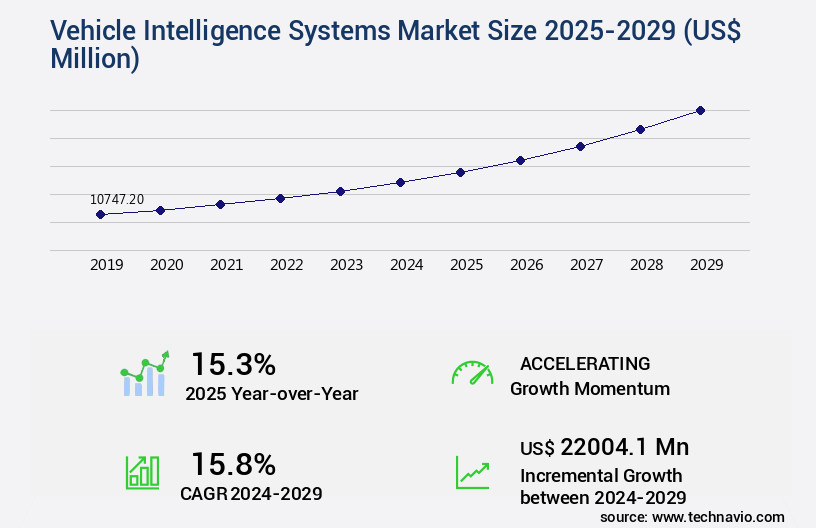
Get Key Insights on Market Forecast (PDF) Request Free Sample
How is the Vehicle Intelligence Systems Market Segmented ?
The vehicle intelligence systems industry research report provides comprehensive data (region-wise segment analysis), with forecasts and estimates in "USD million" for the period 2025-2029, as well as historical data from 2019-2023 for the following segments.
- Component
- Sensors
- Processors
- Analog integrated circuit
- Memory
- Technology
- Adaptive cruise control
- Blind spot detection system
- Park assist system
- Traffic jam assist system
- Alertness sensing system
- Vehicle Type
- Passenger cars
- Commercial vehicles
- Geography
- North America
- Europe
- APAC
- China
- India
- Japan
- South Korea
- South America
- Rest of World (ROW)
By Component Insights
The sensors segment is estimated to witness significant growth during the forecast period.
The market is a dynamic and evolving landscape, marked by advancements in predictive maintenance analytics, data security measures, and the integration of deep learning networks and machine learning models. Computer vision applications, such as traffic flow prediction and route optimization algorithms, are increasingly reliant on object detection algorithms and accident prevention systems. Human-machine interface, edge computing platforms, and autonomous driving technologies are shaping the future of embedded systems design, while cloud-based infrastructure and data analytics dashboards enable remote diagnostics capabilities. The vehicle-to-everything (v2x) communication standard, over-the-air updates, telematics data integration, and driver monitoring systems are essential connectivity protocols.
A recent study reveals that LiDAR sensors account for over 40% of the total the market share, underscoring their importance in providing the necessary redundancy and performance for safe operation under diverse environmental conditions. Innovations in sensor fusion algorithms, fleet management software, vehicle health monitoring, and geofencing technologies continue to drive market growth.
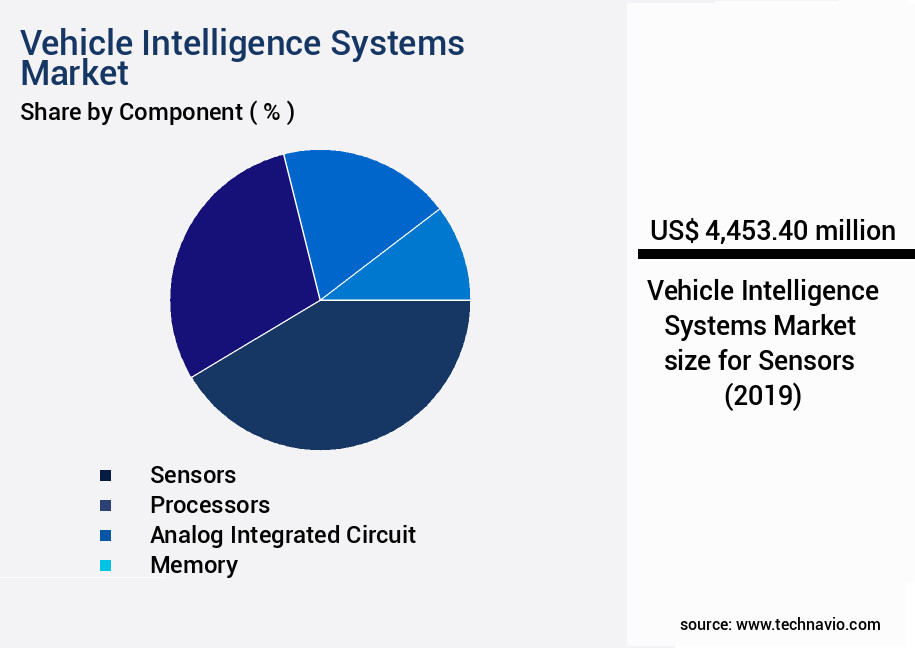
Request Free Sample
The Sensors segment was valued at USD 4.45 billion in 2019 and showed a gradual increase during the forecast period.
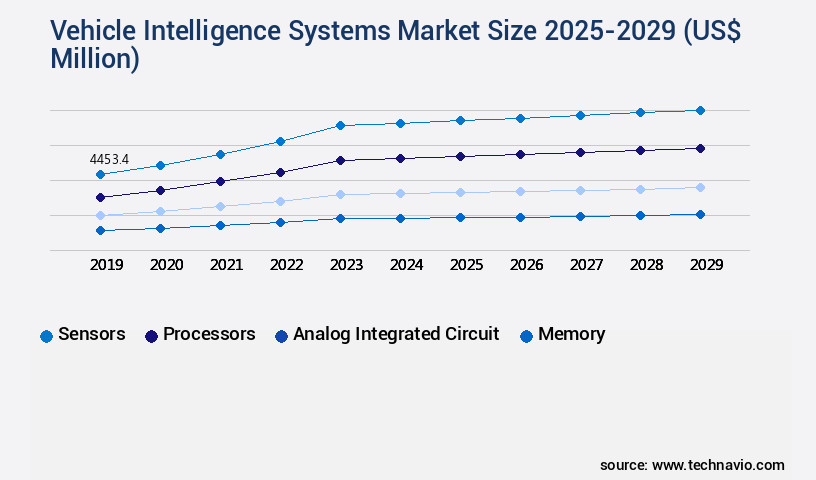
Request Free Sample
Regional Analysis
Europe is estimated to contribute 34% to the growth of the global market during the forecast period.Technavio's analysts have elaborately explained the regional trends and drivers that shape the market during the forecast period.
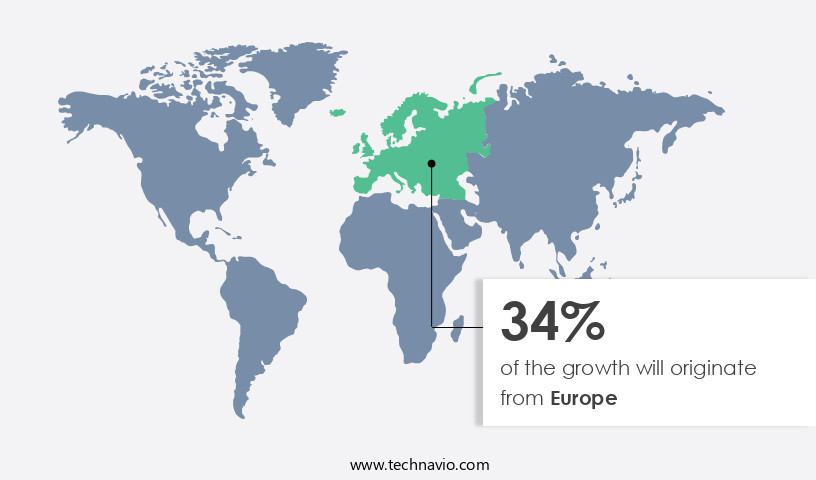
See How Vehicle Intelligence Systems Market Demand is Rising in Europe Request Free Sample
The European the market is characterized by its rigorous regulatory environment, a robust focus on road safety, and the presence of prominent global automobile manufacturers. This region has been a trailblazer in automotive safety innovation, with regulatory bodies and consumer protection agencies setting stringent standards that fuel the adoption of advanced technologies. The European Union's updated General Safety Regulation (GSR II), effective from July 2024, is a significant catalyst for market growth. This regulation mandates the installation of various safety features in all new vehicles, such as Advanced Emergency Braking Systems (AEBS) capable of detecting pedestrians and cyclists, Emergency Lane Keeping Systems (ELKS), Intelligent Speed Assistance (ISA), and Driver Drowsiness and Attention Warning (DDAW).
The implementation of these technologies is expected to lead to substantial operational efficiency gains, cost reductions, and enhanced compliance with safety regulations. According to recent estimates, the European the market is projected to grow at a robust pace, with the number of vehicles equipped with these systems expected to reach over 150 million by 2027.
Market Dynamics
Our researchers analyzed the data with 2024 as the base year, along with the key drivers, trends, and challenges. A holistic analysis of drivers will help companies refine their marketing strategies to gain a competitive advantage.
The market is experiencing significant growth due to the increasing demand for advanced driver assistance systems (ADAS) and the implementation of machine learning in autonomous vehicles. Real-time data processing is essential for vehicle intelligence, enabling functions such as sensor data fusion for improved safety and predictive maintenance using machine learning algorithms. Cybersecurity protocols are also crucial for connected vehicles, ensuring data privacy and protection. ADAS calibration and the development of driver monitoring systems using AI are key areas of focus, with optimization of route planning algorithms for efficiency and integration of vehicle-to-everything communication protocols enhancing fleet management and security. Geofencing is another important feature for fleet management, offering real-time location tracking and alerts.
Functional safety standards are being implemented in ADAS to ensure reliability and prevent accidents, while cloud-based fleet management systems offer integration with data analytics dashboards for visualizing vehicle health and performance. Edge computing is being used for real-time processing of sensor data, reducing latency and improving response times. Accident prevention strategies are being developed using sensor data analysis, with telematics data integration offering valuable insights for improved fleet management. Machine learning algorithms are also being used for real-time traffic flow prediction, enhancing overall efficiency and productivity. Design and implementation of human-machine interfaces for intuitive interaction and optimization of over-the-air updates are also important considerations for the market, as the industry continues to evolve and adapt to the demands of a connected and autonomous future.
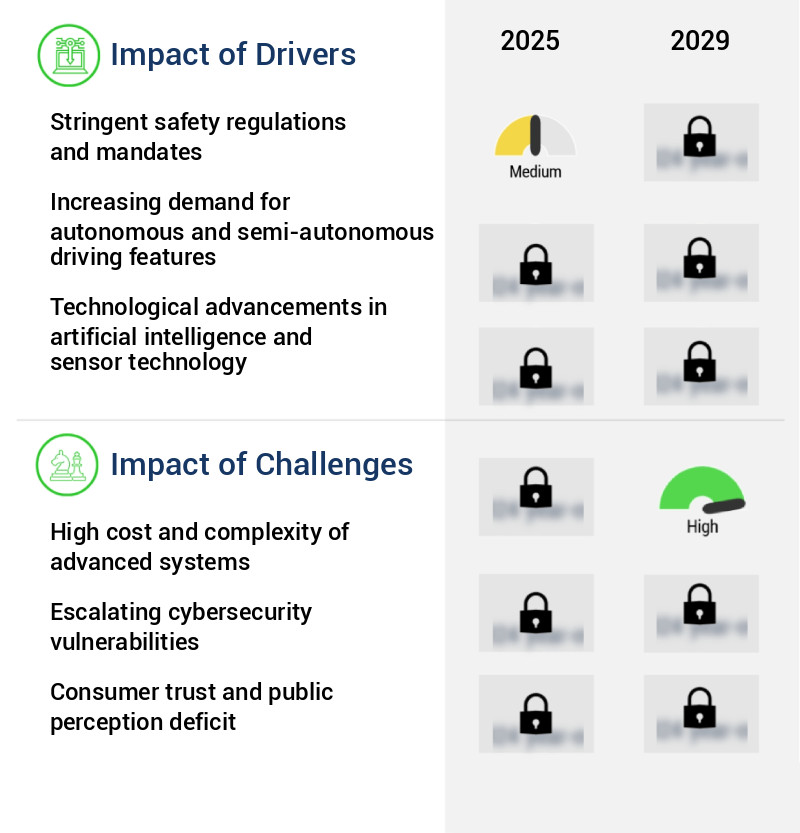
What are the key market drivers leading to the rise in the adoption of Vehicle Intelligence Systems Industry?
- Strict safety regulations and mandates serve as the primary market driver, ensuring compliance and prioritizing safety in all industry applications.
- The market is experiencing significant growth due to the increasing implementation of stringent safety regulations by governments and international bodies. These regulations, aimed at reducing traffic fatalities and injuries, have transformed advanced driver-assistance systems from luxury features to essential equipment. For instance, the European Union's updated General Safety Regulation, effective from July 2024, mandates a suite of advanced safety features for all new vehicles sold within the EU. This regulatory push creates a baseline demand and accelerates automotive original equipment manufacturers' integration of these life-saving technologies. As a result, vehicle intelligence systems' adoption rates have surged, leading to substantial improvements in compliance and safety.
- Additionally, these systems enhance efficiency by reducing downtime and improving decision-making capabilities for fleet operators. For example, predictive maintenance algorithms can forecast potential issues before they escalate, preventing unscheduled downtime and saving costs. Overall, The market represents a strategic investment for businesses seeking to optimize their operations, ensure regulatory compliance, and prioritize safety.
What are the market trends shaping the Vehicle Intelligence Systems Industry?
- The rise of software-defined vehicles represents a significant market trend in the transportation industry. Software-defined vehicles refer to automobiles that utilize advanced software technologies to optimize their functionality and performance.
- The market is experiencing a significant transformation with the increasing adoption of Software-Defined Vehicles (SDV). This shift from hardware-centric designs to a more flexible, software-driven architecture is revolutionizing the automotive industry. According to recent studies, the number of SDVs in production is projected to grow at a remarkable rate, with some estimates suggesting a threefold increase in the next five years. This architectural change enables vehicles to become more adaptive, efficient, and intelligent. For instance, OTA updates allow for improved compliance with regulatory requirements, enhanced decision-making capabilities, and reduced downtime due to maintenance.
- Furthermore, the integration of advanced analytics and machine learning algorithms in vehicle systems can lead to significant accuracy improvements in forecasting fuel consumption, traffic patterns, and predictive maintenance.
What challenges does the Vehicle Intelligence Systems Industry face during its growth?
- The high cost and complexity of advanced systems pose a significant challenge to the industry's growth, necessitating continuous innovation and optimization to make these technologies more accessible and affordable for businesses.
- The market is witnessing significant evolution, driven by the development and integration of advanced driver-assistance systems (ADAS) and autonomous driving technologies. These innovations necessitate substantial investments in specialized engineering talent, extensive testing, and sophisticated software and hardware. The sensor suite, which includes high-resolution cameras, advanced radar, and particularly LiDAR, adds a considerable cost to the price of a vehicle. For instance, the cost to add Tesla's Full Self-Driving package was fifteen thousand dollars in January 2023. Despite these challenges, the market's potential benefits, such as improved efficiency, enhanced regulatory compliance, and optimized costs, continue to fuel its growth.
- The integration of vehicle intelligence systems enables vehicles to collect and analyze real-time data, facilitating predictive maintenance and optimized fleet management.
Exclusive Technavio Analysis on Customer Landscape
The vehicle intelligence systems market forecasting report includes the adoption lifecycle of the market, covering from the innovator's stage to the laggard's stage. It focuses on adoption rates in different regions based on penetration. Furthermore, the vehicle intelligence systems market report also includes key purchase criteria and drivers of price sensitivity to help companies evaluate and develop their market growth analysis strategies.
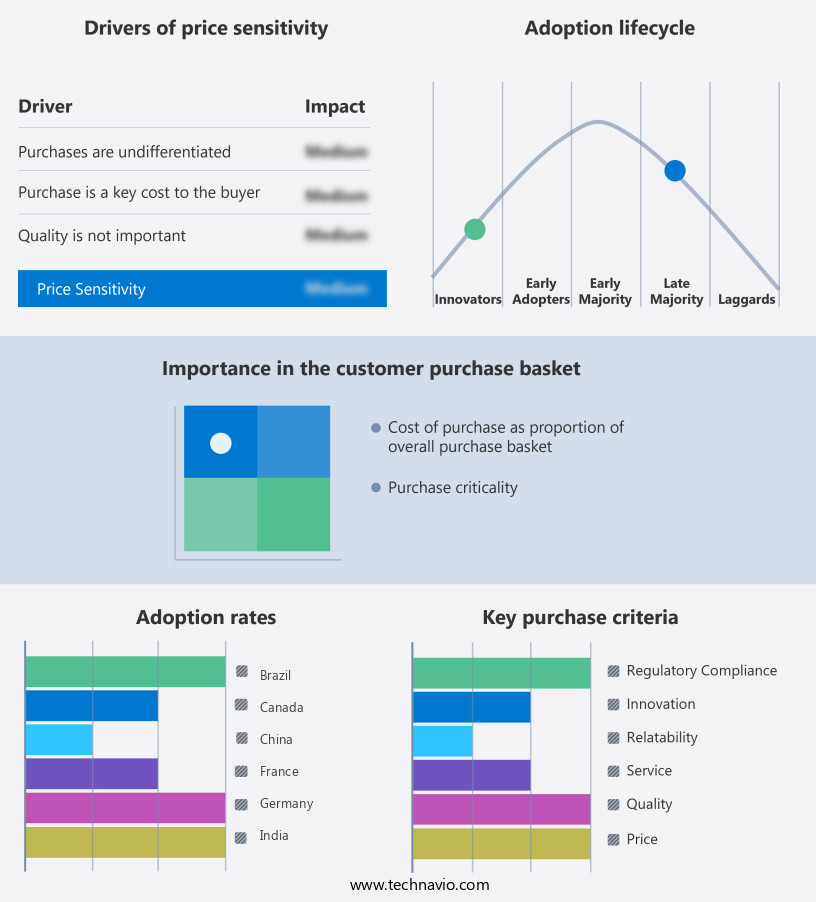
Customer Landscape of Vehicle Intelligence Systems Industry
Competitive Landscape
Companies are implementing various strategies, such as strategic alliances, vehicle intelligence systems market forecast, partnerships, mergers and acquisitions, geographical expansion, and product/service launches, to enhance their presence in the industry.
Aptiv Plc - The company specializes in advanced vehicle intelligence technologies, including radar-based Advanced Driver-Assistance Systems (ADAS) and Level 4 robotaxi solutions for autonomous urban mobility. These innovations enhance safety and efficiency in transportation systems.
The industry research and growth report includes detailed analyses of the competitive landscape of the market and information about key companies, including:
- Aptiv Plc
- Autoliv Inc.
- Baidu Inc.
- BMW AG
- BYD Co. Ltd.
- Continental AG
- DENSO Corp.
- Intel Corp.
- Luminar Technologies Inc.
- Mobileye Technologies Ltd.
- NIO Ltd.
- NVIDIA Corp.
- Pony.ai
- Qualcomm Inc.
- Robert Bosch GmbH
- Tesla Inc.
- Waymo LLC
- XPeng Inc.
- Zoox
Qualitative and quantitative analysis of companies has been conducted to help clients understand the wider business environment as well as the strengths and weaknesses of key industry players. Data is qualitatively analyzed to categorize companies as pure play, category-focused, industry-focused, and diversified; it is quantitatively analyzed to categorize companies as dominant, leading, strong, tentative, and weak.
Recent Development and News in Vehicle Intelligence Systems Market
- In August 2024, Magna International, a leading automotive supplier, announced the launch of its new advanced driver-assistance system (ADAS) platform, 'Magna Steer Plus.' This system integrates steer-by-wire technology, enabling vehicles to offer enhanced safety features and improved driving experiences (Magna International Press Release, 2024).
- In November 2024, Intel and BMW Group entered into a strategic partnership to develop next-generation vehicle intelligence systems. The collaboration aimed to integrate Intel's Mobileye technology into BMW vehicles, enhancing advanced driver-assistance systems and autonomous driving capabilities (Intel Press Release, 2024).
- In February 2025, Bosch and Continental AG announced their merger in the automotive technology sector, creating a leading supplier of vehicle intelligence systems. The combined entity, Bosch Continental, would focus on developing advanced driver-assistance systems, electric vehicle components, and connectivity solutions (Bosch Press Release, 2025).
- In May 2025, the European Union passed the 'European Union Regulation on Vehicle Intelligence Unit,' mandating the installation of intelligent transport systems in all new vehicles from 2027. The regulation aims to improve road safety, reduce congestion, and promote sustainable transportation (European Commission Press Release, 2025).
Dive into Technavio's robust research methodology, blending expert interviews, extensive data synthesis, and validated models for unparalleled Vehicle Intelligence Systems Market insights. See full methodology.
|
Market Scope
|
|
Report Coverage
|
Details
|
|
Page number
|
248
|
|
Base year
|
2024
|
|
Historic period
|
2019-2023 |
|
Forecast period
|
2025-2029
|
|
Growth momentum & CAGR
|
Accelerate at a CAGR of 15.8%
|
|
Market growth 2025-2029
|
USD 22004.1 million
|
|
Market structure
|
Fragmented
|
|
YoY growth 2024-2025(%)
|
15.3
|
|
Key countries
|
US, UK, Germany, China, France, Canada, Japan, India, South Korea, and Brazil
|
|
Competitive landscape
|
Leading Companies, Market Positioning of Companies, Competitive Strategies, and Industry Risks
|
Request Free Sample
Research Analyst Overview
- The market continues to evolve, driven by advancements in predictive maintenance analytics, data security measures, and the integration of deep learning networks and machine learning models. These technologies enable computer vision applications, such as traffic flow prediction and route optimization algorithms, which are essential for optimizing fleet management and enhancing overall transportation efficiency. Object detection algorithms and accident prevention systems are becoming increasingly common, with driver behavior analysis playing a crucial role in improving road safety. Human-machine interface design and edge computing platforms are essential components of autonomous driving technologies, enabling real-time data processing and sensor fusion algorithms. Moreover, vehicle-to-everything (V2X) connectivity, over-the-air updates, and telematics data integration are transforming the industry.
- According to a recent study, The market is expected to grow by over 20% annually, with significant investments in driver monitoring systems, connectivity protocols, fuel efficiency monitoring, and in-vehicle infotainment systems. For instance, a leading automotive manufacturer reported a 30% reduction in maintenance costs by implementing predictive maintenance analytics and remote diagnostics capabilities. This success underscores the market's potential to revolutionize the transportation sector, offering significant benefits in terms of safety, efficiency, and cost savings.
What are the Key Data Covered in this Vehicle Intelligence Systems Market Research and Growth Report?
-
What is the expected growth of the Vehicle Intelligence Systems Market between 2025 and 2029?
-
What segmentation does the market report cover?
-
The report is segmented by Component (Sensors, Processors, Analog integrated circuit, and Memory), Technology (Adaptive cruise control, Blind spot detection system, Park assist system, Traffic jam assist system, and Alertness sensing system), Vehicle Type (Passenger cars and Commercial vehicles), and Geography (Europe, North America, APAC, South America, and Middle East and Africa)
-
Which regions are analyzed in the report?
-
Europe, North America, APAC, South America, and Middle East and Africa
-
What are the key growth drivers and market challenges?
-
Who are the major players in the Vehicle Intelligence Systems Market?
-
Aptiv Plc, Autoliv Inc., Baidu Inc., BMW AG, BYD Co. Ltd., Continental AG, DENSO Corp., Intel Corp., Luminar Technologies Inc., Mobileye Technologies Ltd., NIO Ltd., NVIDIA Corp., Pony.ai, Qualcomm Inc., Robert Bosch GmbH, Tesla Inc., Waymo LLC, XPeng Inc., and Zoox
Market Research Insights
- The market continues to evolve, driven by advancements in technologies such as ADAS calibration techniques, parking assist, and hardware acceleration. For instance, the integration of radar sensors in collision avoidance systems has resulted in a significant reduction in rear-end collisions by up to 40%. Furthermore, industry experts anticipate a compound annual growth rate of over 20% in the next decade due to the increasing demand for advanced safety features and connectivity solutions. These expectations are fueled by the integration of technologies like CAN bus communication, system integration challenges, and data encryption standards, which enable seamless data exchange and secure storage in cloud solutions.
- Additionally, the adoption of predictive modeling techniques and real-time tracking systems enhances performance optimization strategies, such as adaptive cruise control and automatic emergency braking. These developments underscore the continuous evolution of the market.
We can help! Our analysts can customize this vehicle intelligence systems market research report to meet your requirements.
Get in touch
1 Executive Summary
- 1.1 Market overview
- Executive Summary - Chart on Market Overview
- Executive Summary - Data Table on Market Overview
- Executive Summary - Chart on Global Market Characteristics
- Executive Summary - Chart on Market by Geography
- Executive Summary - Chart on Market Segmentation by Component
- Executive Summary - Chart on Market Segmentation by Technology
- Executive Summary - Chart on Market Segmentation by Vehicle Type
- Executive Summary - Chart on Incremental Growth
- Executive Summary - Data Table on Incremental Growth
- Executive Summary - Chart on Company Market Positioning
2 Technavio Analysis
- 2.1 Analysis of price sensitivity, lifecycle, customer purchase basket, adoption rates, and purchase criteria
- Analysis of price sensitivity, lifecycle, customer purchase basket, adoption rates, and purchase criteria
- 2.2 Criticality of inputs and Factors of differentiation
- Overview on criticality of inputs and factors of differentiation
- 2.3 Factors of disruption
- Overview on factors of disruption
- 2.4 Impact of drivers and challenges
- Impact of drivers and challenges in 2024 and 2029
3 Market Landscape
- 3.1 Market ecosystem
- Parent Market
- Data Table on - Parent Market
- 3.2 Market characteristics
- Market characteristics analysis
4 Market Sizing
- 4.1 Market definition
- Offerings of companies included in the market definition
- 4.2 Market segment analysis
- 4.4 Market outlook: Forecast for 2024-2029
- Chart on Global - Market size and forecast 2024-2029 ($ million)
- Data Table on Global - Market size and forecast 2024-2029 ($ million)
- Chart on Global Market: Year-over-year growth 2024-2029 (%)
- Data Table on Global Market: Year-over-year growth 2024-2029 (%)
5 Historic Market Size
- 5.1 Global Vehicle Intelligence Systems Market 2019 - 2023
- Historic Market Size - Data Table on Global Vehicle Intelligence Systems Market 2019 - 2023 ($ million)
- 5.2 Component segment analysis 2019 - 2023
- Historic Market Size - Component Segment 2019 - 2023 ($ million)
- 5.3 Technology segment analysis 2019 - 2023
- Historic Market Size - Technology Segment 2019 - 2023 ($ million)
- 5.4 Vehicle Type segment analysis 2019 - 2023
- Historic Market Size - Vehicle Type Segment 2019 - 2023 ($ million)
- 5.5 Geography segment analysis 2019 - 2023
- Historic Market Size - Geography Segment 2019 - 2023 ($ million)
- 5.6 Country segment analysis 2019 - 2023
- Historic Market Size - Country Segment 2019 - 2023 ($ million)
6 Five Forces Analysis
- 6.1 Five forces summary
- Five forces analysis - Comparison between 2024 and 2029
- 6.2 Bargaining power of buyers
- Bargaining power of buyers - Impact of key factors 2024 and 2029
- 6.3 Bargaining power of suppliers
- Bargaining power of suppliers - Impact of key factors in 2024 and 2029
- 6.4 Threat of new entrants
- Threat of new entrants - Impact of key factors in 2024 and 2029
- 6.5 Threat of substitutes
- Threat of substitutes - Impact of key factors in 2024 and 2029
- 6.6 Threat of rivalry
- Threat of rivalry - Impact of key factors in 2024 and 2029
- 6.7 Market condition
- Chart on Market condition - Five forces 2024 and 2029
7 Market Segmentation by Component
- 7.1 Market segments
- Chart on Component - Market share 2024-2029 (%)
- Data Table on Component - Market share 2024-2029 (%)
- 7.2 Comparison by Component
- Chart on Comparison by Component
- Data Table on Comparison by Component
- 7.3 Sensors - Market size and forecast 2024-2029
- Chart on Sensors - Market size and forecast 2024-2029 ($ million)
- Data Table on Sensors - Market size and forecast 2024-2029 ($ million)
- Chart on Sensors - Year-over-year growth 2024-2029 (%)
- Data Table on Sensors - Year-over-year growth 2024-2029 (%)
- 7.4 Processors - Market size and forecast 2024-2029
- Chart on Processors - Market size and forecast 2024-2029 ($ million)
- Data Table on Processors - Market size and forecast 2024-2029 ($ million)
- Chart on Processors - Year-over-year growth 2024-2029 (%)
- Data Table on Processors - Year-over-year growth 2024-2029 (%)
- 7.5 Analog integrated circuit - Market size and forecast 2024-2029
- Chart on Analog integrated circuit - Market size and forecast 2024-2029 ($ million)
- Data Table on Analog integrated circuit - Market size and forecast 2024-2029 ($ million)
- Chart on Analog integrated circuit - Year-over-year growth 2024-2029 (%)
- Data Table on Analog integrated circuit - Year-over-year growth 2024-2029 (%)
- 7.6 Memory - Market size and forecast 2024-2029
- Chart on Memory - Market size and forecast 2024-2029 ($ million)
- Data Table on Memory - Market size and forecast 2024-2029 ($ million)
- Chart on Memory - Year-over-year growth 2024-2029 (%)
- Data Table on Memory - Year-over-year growth 2024-2029 (%)
- 7.7 Market opportunity by Component
- Market opportunity by Component ($ million)
- Data Table on Market opportunity by Component ($ million)
8 Market Segmentation by Technology
- 8.1 Market segments
- Chart on Technology - Market share 2024-2029 (%)
- Data Table on Technology - Market share 2024-2029 (%)
- 8.2 Comparison by Technology
- Chart on Comparison by Technology
- Data Table on Comparison by Technology
- 8.3 Adaptive cruise control - Market size and forecast 2024-2029
- Chart on Adaptive cruise control - Market size and forecast 2024-2029 ($ million)
- Data Table on Adaptive cruise control - Market size and forecast 2024-2029 ($ million)
- Chart on Adaptive cruise control - Year-over-year growth 2024-2029 (%)
- Data Table on Adaptive cruise control - Year-over-year growth 2024-2029 (%)
- 8.4 Blind spot detection system - Market size and forecast 2024-2029
- Chart on Blind spot detection system - Market size and forecast 2024-2029 ($ million)
- Data Table on Blind spot detection system - Market size and forecast 2024-2029 ($ million)
- Chart on Blind spot detection system - Year-over-year growth 2024-2029 (%)
- Data Table on Blind spot detection system - Year-over-year growth 2024-2029 (%)
- 8.5 Park assist system - Market size and forecast 2024-2029
- Chart on Park assist system - Market size and forecast 2024-2029 ($ million)
- Data Table on Park assist system - Market size and forecast 2024-2029 ($ million)
- Chart on Park assist system - Year-over-year growth 2024-2029 (%)
- Data Table on Park assist system - Year-over-year growth 2024-2029 (%)
- 8.6 Traffic jam assist system - Market size and forecast 2024-2029
- Chart on Traffic jam assist system - Market size and forecast 2024-2029 ($ million)
- Data Table on Traffic jam assist system - Market size and forecast 2024-2029 ($ million)
- Chart on Traffic jam assist system - Year-over-year growth 2024-2029 (%)
- Data Table on Traffic jam assist system - Year-over-year growth 2024-2029 (%)
- 8.7 Alertness sensing system - Market size and forecast 2024-2029
- Chart on Alertness sensing system - Market size and forecast 2024-2029 ($ million)
- Data Table on Alertness sensing system - Market size and forecast 2024-2029 ($ million)
- Chart on Alertness sensing system - Year-over-year growth 2024-2029 (%)
- Data Table on Alertness sensing system - Year-over-year growth 2024-2029 (%)
- 8.8 Market opportunity by Technology
- Market opportunity by Technology ($ million)
- Data Table on Market opportunity by Technology ($ million)
9 Market Segmentation by Vehicle Type
- 9.1 Market segments
- Chart on Vehicle Type - Market share 2024-2029 (%)
- Data Table on Vehicle Type - Market share 2024-2029 (%)
- 9.2 Comparison by Vehicle Type
- Chart on Comparison by Vehicle Type
- Data Table on Comparison by Vehicle Type
- 9.3 Passenger cars - Market size and forecast 2024-2029
- Chart on Passenger cars - Market size and forecast 2024-2029 ($ million)
- Data Table on Passenger cars - Market size and forecast 2024-2029 ($ million)
- Chart on Passenger cars - Year-over-year growth 2024-2029 (%)
- Data Table on Passenger cars - Year-over-year growth 2024-2029 (%)
- 9.4 Commercial vehicles - Market size and forecast 2024-2029
- Chart on Commercial vehicles - Market size and forecast 2024-2029 ($ million)
- Data Table on Commercial vehicles - Market size and forecast 2024-2029 ($ million)
- Chart on Commercial vehicles - Year-over-year growth 2024-2029 (%)
- Data Table on Commercial vehicles - Year-over-year growth 2024-2029 (%)
- 9.5 Market opportunity by Vehicle Type
- Market opportunity by Vehicle Type ($ million)
- Data Table on Market opportunity by Vehicle Type ($ million)
10 Customer Landscape
- 10.1 Customer landscape overview
- Analysis of price sensitivity, lifecycle, customer purchase basket, adoption rates, and purchase criteria
11 Geographic Landscape
- 11.1 Geographic segmentation
- Chart on Market share by geography 2024-2029 (%)
- Data Table on Market share by geography 2024-2029 (%)
- 11.2 Geographic comparison
- Chart on Geographic comparison
- Data Table on Geographic comparison
- 11.3 Europe - Market size and forecast 2024-2029
- Chart on Europe - Market size and forecast 2024-2029 ($ million)
- Data Table on Europe - Market size and forecast 2024-2029 ($ million)
- Chart on Europe - Year-over-year growth 2024-2029 (%)
- Data Table on Europe - Year-over-year growth 2024-2029 (%)
- 11.4 North America - Market size and forecast 2024-2029
- Chart on North America - Market size and forecast 2024-2029 ($ million)
- Data Table on North America - Market size and forecast 2024-2029 ($ million)
- Chart on North America - Year-over-year growth 2024-2029 (%)
- Data Table on North America - Year-over-year growth 2024-2029 (%)
- 11.5 APAC - Market size and forecast 2024-2029
- Chart on APAC - Market size and forecast 2024-2029 ($ million)
- Data Table on APAC - Market size and forecast 2024-2029 ($ million)
- Chart on APAC - Year-over-year growth 2024-2029 (%)
- Data Table on APAC - Year-over-year growth 2024-2029 (%)
- 11.6 South America - Market size and forecast 2024-2029
- Chart on South America - Market size and forecast 2024-2029 ($ million)
- Data Table on South America - Market size and forecast 2024-2029 ($ million)
- Chart on South America - Year-over-year growth 2024-2029 (%)
- Data Table on South America - Year-over-year growth 2024-2029 (%)
- 11.7 Middle East and Africa - Market size and forecast 2024-2029
- Chart on Middle East and Africa - Market size and forecast 2024-2029 ($ million)
- Data Table on Middle East and Africa - Market size and forecast 2024-2029 ($ million)
- Chart on Middle East and Africa - Year-over-year growth 2024-2029 (%)
- Data Table on Middle East and Africa - Year-over-year growth 2024-2029 (%)
- 11.8 US - Market size and forecast 2024-2029
- Chart on US - Market size and forecast 2024-2029 ($ million)
- Data Table on US - Market size and forecast 2024-2029 ($ million)
- Chart on US - Year-over-year growth 2024-2029 (%)
- Data Table on US - Year-over-year growth 2024-2029 (%)
- 11.9 Germany - Market size and forecast 2024-2029
- Chart on Germany - Market size and forecast 2024-2029 ($ million)
- Data Table on Germany - Market size and forecast 2024-2029 ($ million)
- Chart on Germany - Year-over-year growth 2024-2029 (%)
- Data Table on Germany - Year-over-year growth 2024-2029 (%)
- 11.10 UK - Market size and forecast 2024-2029
- Chart on UK - Market size and forecast 2024-2029 ($ million)
- Data Table on UK - Market size and forecast 2024-2029 ($ million)
- Chart on UK - Year-over-year growth 2024-2029 (%)
- Data Table on UK - Year-over-year growth 2024-2029 (%)
- 11.11 China - Market size and forecast 2024-2029
- Chart on China - Market size and forecast 2024-2029 ($ million)
- Data Table on China - Market size and forecast 2024-2029 ($ million)
- Chart on China - Year-over-year growth 2024-2029 (%)
- Data Table on China - Year-over-year growth 2024-2029 (%)
- 11.12 France - Market size and forecast 2024-2029
- Chart on France - Market size and forecast 2024-2029 ($ million)
- Data Table on France - Market size and forecast 2024-2029 ($ million)
- Chart on France - Year-over-year growth 2024-2029 (%)
- Data Table on France - Year-over-year growth 2024-2029 (%)
- 11.13 Canada - Market size and forecast 2024-2029
- Chart on Canada - Market size and forecast 2024-2029 ($ million)
- Data Table on Canada - Market size and forecast 2024-2029 ($ million)
- Chart on Canada - Year-over-year growth 2024-2029 (%)
- Data Table on Canada - Year-over-year growth 2024-2029 (%)
- 11.14 Japan - Market size and forecast 2024-2029
- Chart on Japan - Market size and forecast 2024-2029 ($ million)
- Data Table on Japan - Market size and forecast 2024-2029 ($ million)
- Chart on Japan - Year-over-year growth 2024-2029 (%)
- Data Table on Japan - Year-over-year growth 2024-2029 (%)
- 11.15 India - Market size and forecast 2024-2029
- Chart on India - Market size and forecast 2024-2029 ($ million)
- Data Table on India - Market size and forecast 2024-2029 ($ million)
- Chart on India - Year-over-year growth 2024-2029 (%)
- Data Table on India - Year-over-year growth 2024-2029 (%)
- 11.16 Brazil - Market size and forecast 2024-2029
- Chart on Brazil - Market size and forecast 2024-2029 ($ million)
- Data Table on Brazil - Market size and forecast 2024-2029 ($ million)
- Chart on Brazil - Year-over-year growth 2024-2029 (%)
- Data Table on Brazil - Year-over-year growth 2024-2029 (%)
- 11.17 South Korea - Market size and forecast 2024-2029
- Chart on South Korea - Market size and forecast 2024-2029 ($ million)
- Data Table on South Korea - Market size and forecast 2024-2029 ($ million)
- Chart on South Korea - Year-over-year growth 2024-2029 (%)
- Data Table on South Korea - Year-over-year growth 2024-2029 (%)
- 11.18 Market opportunity by geography
- Market opportunity by geography ($ million)
- Data Tables on Market opportunity by geography ($ million)
12 Drivers, Challenges, and Opportunity/Restraints
- 12.3 Impact of drivers and challenges
- Impact of drivers and challenges in 2024 and 2029
- 12.4 Market opportunities/restraints
13 Competitive Landscape
- 13.2 Competitive Landscape
- Overview on criticality of inputs and factors of differentiation
- 13.3 Landscape disruption
- Overview on factors of disruption
- 13.4 Industry risks
- Impact of key risks on business
14 Competitive Analysis
- 14.2 Company ranking index
- 14.3 Market positioning of companies
- Matrix on companies position and classification
- 14.4 Aptiv Plc
- Aptiv Plc - Overview
- Aptiv Plc - Business segments
- Aptiv Plc - Key news
- Aptiv Plc - Key offerings
- Aptiv Plc - Segment focus
- SWOT
- 14.5 Autoliv Inc.
- Autoliv Inc. - Overview
- Autoliv Inc. - Product / Service
- Autoliv Inc. - Key news
- Autoliv Inc. - Key offerings
- SWOT
- 14.6 Baidu Inc.
- Baidu Inc. - Overview
- Baidu Inc. - Business segments
- Baidu Inc. - Key offerings
- Baidu Inc. - Segment focus
- SWOT
- 14.7 BMW AG
- BMW AG - Overview
- BMW AG - Business segments
- BMW AG - Key offerings
- BMW AG - Segment focus
- SWOT
- 14.8 BYD Co. Ltd.
- BYD Co. Ltd. - Overview
- BYD Co. Ltd. - Business segments
- BYD Co. Ltd. - Key news
- BYD Co. Ltd. - Key offerings
- BYD Co. Ltd. - Segment focus
- SWOT
- 14.9 Continental AG
- Continental AG - Overview
- Continental AG - Business segments
- Continental AG - Key news
- Continental AG - Key offerings
- Continental AG - Segment focus
- SWOT
- 14.10 DENSO Corp.
- DENSO Corp. - Overview
- DENSO Corp. - Business segments
- DENSO Corp. - Key news
- DENSO Corp. - Key offerings
- DENSO Corp. - Segment focus
- SWOT
- 14.11 Intel Corp.
- Intel Corp. - Overview
- Intel Corp. - Business segments
- Intel Corp. - Key news
- Intel Corp. - Key offerings
- Intel Corp. - Segment focus
- SWOT
- 14.12 Mobileye Technologies Ltd.
- Mobileye Technologies Ltd. - Overview
- Mobileye Technologies Ltd. - Product / Service
- Mobileye Technologies Ltd. - Key offerings
- SWOT
- 14.13 NVIDIA Corp.
- NVIDIA Corp. - Overview
- NVIDIA Corp. - Business segments
- NVIDIA Corp. - Key news
- NVIDIA Corp. - Key offerings
- NVIDIA Corp. - Segment focus
- SWOT
- 14.14 Pony.ai
- Pony.ai - Overview
- Pony.ai - Product / Service
- Pony.ai - Key offerings
- SWOT
- 14.15 Qualcomm Inc.
- Qualcomm Inc. - Overview
- Qualcomm Inc. - Business segments
- Qualcomm Inc. - Key news
- Qualcomm Inc. - Key offerings
- Qualcomm Inc. - Segment focus
- SWOT
- 14.16 Robert Bosch GmbH
- Robert Bosch GmbH - Overview
- Robert Bosch GmbH - Product / Service
- Robert Bosch GmbH - Key news
- Robert Bosch GmbH - Key offerings
- SWOT
- 14.17 Tesla Inc.
- Tesla Inc. - Overview
- Tesla Inc. - Business segments
- Tesla Inc. - Key news
- Tesla Inc. - Key offerings
- Tesla Inc. - Segment focus
- SWOT
- 14.18 Waymo LLC
- Waymo LLC - Overview
- Waymo LLC - Product / Service
- Waymo LLC - Key offerings
- SWOT
15 Appendix
- 15.2 Inclusions and exclusions checklist
- Inclusions checklist
- Exclusions checklist
- 15.3 Currency conversion rates for US$
- Currency conversion rates for US$
- 15.4 Research methodology
- 15.7 Validation techniques employed for market sizing
- Validation techniques employed for market sizing
- 15.9 360 degree market analysis
- 360 degree market analysis
- 15.10 List of abbreviations







![]() Get the report (PDF) sent to your email within minutes.
Get the report (PDF) sent to your email within minutes.
Complimentary full Excel data with your report purchase.